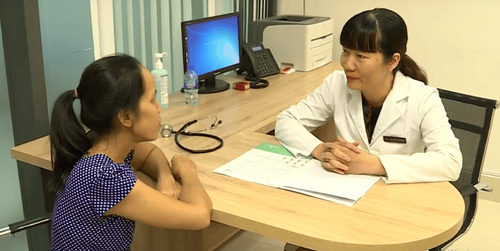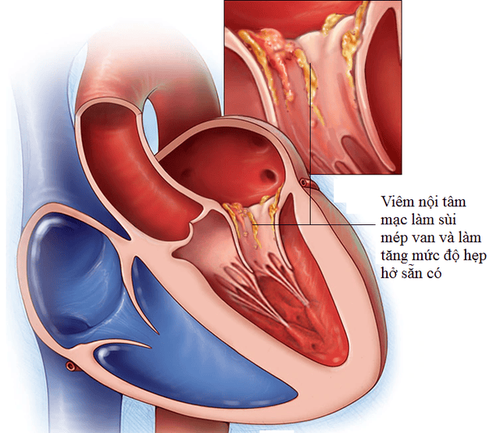This is an automatically translated article.
The article was professionally consulted with Master, Doctor Ngo Thi Oanh - Pediatrician - Department of Pediatrics - Neonatology - Vinmec Ha Long International General Hospital.Children do not swallow all the food (because the child does not want to eat or due to a medical condition) is a common condition in many children that causes "headaches" for parents. Dysphagia in children can cause adverse effects on dietary intake, growth and development. Therefore, parents need to determine the exact cause to find a way to handle it. The following article will help you better understand how to identify and handle dysphagia in children.
1. What is dysphagia?
Dysphagia is a condition where it takes a lot of time and effort to push food or liquid from the mouth down to the stomach. Difficulty swallowing is also sometimes painful. In some cases, it may even be impossible to swallow food. The process of swallowing and breathing occurs together in the pharynx, so when there is a problem with one of these processes, or the lack of synchronization of swallowing and breathing, it can affect the ability of the child to protect the airway when breathing. Swallow and eat safe liquids and foods.According to statistics, dysphagia in children accounts for only 1% of the general population. Difficulty swallowing can be detrimental to the lungs as well as affect the nutrition supply process for the child's body.
2. How to recognize dysphagia
Eating or drinking behavior in children can be divided into four main stages:Oral phase includes: sucking or chewing, locomotion, pushing food down the throat Activation of swallowing reflex Pharyngeal stage: Transporting food through the pharynx Esophageal stage: Transporting food through the esophagus and down the stomach The child does not want to eat despite the ability to eat with symptoms similar to dysphagia due to dysphagia.
Typical symptoms when children have dysphagia:
Manifestations in the oral stage:
Loss of reflexes in the mouth such as: Weak sucking, lack of coordination in sucking and sucking, immature bite movements or chewing, biting or chewing disorders, poor ejection and food blocking.
Swallowing reflex:
The child has lost swallowing reflex, delayed stimulation of swallowing reflex, there is no coordination of sucking/swallowing/breathing movements.
Pharyngeal stage:
When food enters the pharynx, causing entry into the larynx, the child shows signs of aspiration, choking, food backlog in the throat, regurgitation of the nasopharynx.

Khó nuốt ở trẻ em có thể do bệnh lý hoặc do bé không muốn ăn
3. Causes of dysphagia in children
Children with dysphagia can be caused by:Children with cerebral palsy, acquired/traumatic brain damage, other neuromuscular disorders Children with craniofacial malformations, airway defects Congenital heart disease , digestive problems, eating injuries Cleft lips or palates Premature, low birth weight babies are also at risk for dysphagia.
4. Complications when children have difficulty swallowing
Malnourished and dehydrated children: Difficulty swallowing makes it difficult to provide food and nutrients to nourish the body, especially children in the weaning period as well as the period when they need to supplement a lot of nutrients. Children with difficulty swallowing are at risk of malnutrition and dehydration.Have breathing problems. If food enters the respiratory tract, if the child tries to swallow it will cause respiratory problems or infection, if this condition persists, it can cause pneumonia or upper respiratory infection.
Research shows that pediatric patients with multi-organ disease diagnoses, besides dysphagia, are at greatest risk of developing pneumonia.

Tình trạng trẻ khó nuốt làm tăng nguy cơ bị suy dinh dưỡng và mất nước
5. Treatment of dysphagia in children
To diagnose a child with dysphagia, the doctor will examine using the following techniques:Television-enhanced X-ray (VFSS) and flexible endoscopic swallowing assessment (FEES) are tools Most commonly used assessment in dysphagia in children. VFSS allows assessment of all stages of swallowing.
FEES test: FEES provides images of the larynx and hypopharynx before and after (but not during) the pharyngeal phase of swallowing, helping to detect structural defects and swallowing physiology, as well as evaluate on the risk of aspiration. FEES is a safe and effective tool for assessing dysphagia in children and also allows assessment of pharyngeal sensation in children.
Interventional treatment for children with oral-stage swallowing problems often includes exercises to improve the sensory and/or motor skills needed for eating.
6. Care and treatment of dysphagia in children
Use solid products to help children swallow food easilyUse gelatin in combination with cookies, fruit purees, cakes,... Use flour or cornstarch to thicken the liquid. Use commercially available thickening products to adjust the consistency of liquids Rice cereals for babies or for ready-to-eat meals, feeding children yogurt, whey, etc. Change the texture or size of ingredients solid foods by boiling, baking, mixing, mashing or pureeing foods to make them easier to eat Using specialized feeding tools such as bottles, pacifiers, spoons, spoons,... Change posture and/or seat; change the rate of feeding by feeding the child slowly Divide into several small meals for the child Follow the advice and instructions of the doctor. Take your child for regular check-ups.
With many years of experience in examining and treating diseases in children, now the Pediatrics Department at Vinmec International General Hospital has become one of the major health care centers, capable of examining , screening and treatment of many specialized diseases in children. Therefore, if the child shows signs of poor absorption of nutrients, slow weight gain, growth retardation, etc., parents can take the child to Vinmec International General Hospital for examination and support. advice from qualified doctors.
Please dial HOTLINE for more information or register for an appointment HERE. Download MyVinmec app to make appointments faster and to manage your bookings easily.
Reference source: nestlenutrition-institute.org













